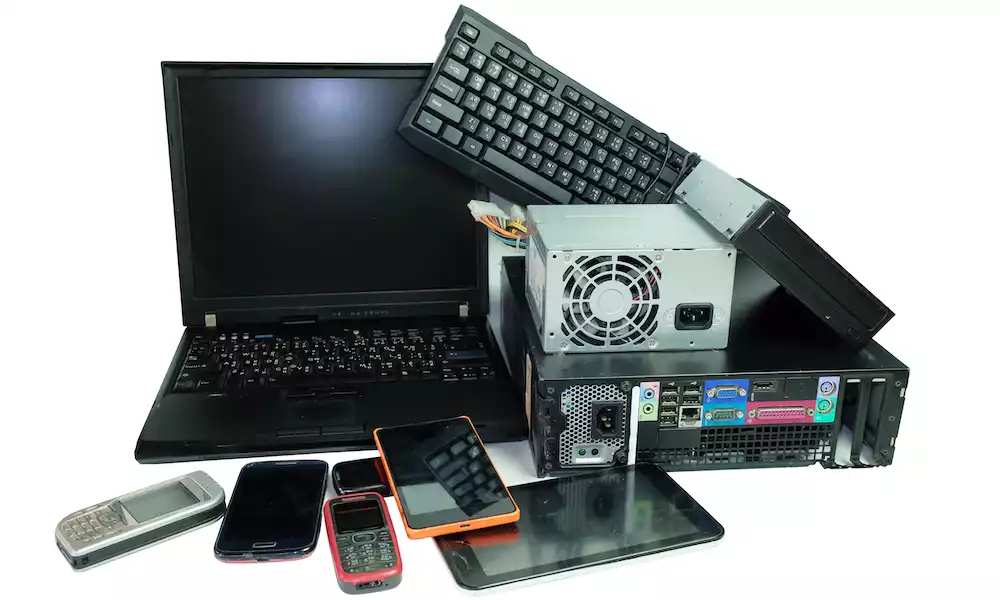General
eWaste And Managing Large Quantities Of IT Equipment

eWaste is an emerging trend that most organisations are struggling to address.
What is eWaste? It is short for electronic waste and refers to discarded hardware – laptops, computers, smartphones, printers, etc.
The improper disposal of electronic waste can have serious environmental and health consequences due to hazardous materials like lead, mercury, cadmium, arsenic, and brominated flame retardants in these devices.
While we have been discarding IT equipment for decades, innovations in the industry seem to be generating electronic waste at a record rate.
Climate change is a genuine problem, and this type of waste is a substantial contributing factor. Businesses need to focus their attention on how they are dealing with their discarded IT equipment. eWaste management needs solutions – and fast.
The Issue With eWaste
Today our eyes are on the next best thing, namely emerging technologies. What we’re not addressing adequately is the challenges posted by eWaste.
At first glance, it’s easy to assume that e-waste will be taking up significant space in landfills across the globe. However, the issue is deeper than that. There is much more to be concerned about than just the volume of waste generated.
Toxic substances
Electronic devices often contain toxic substances like lead and mercury. When waste is not handled correctly, it can expose workers in recycling facilities and informal waste collection sectors to poisonous substances, leading to health problems and long-term health risks.
Plus, improper waste disposal, such as throwing it in landfills or incinerating it, can release harmful chemicals into the soil and air, polluting the environment and contaminating water sources.
Resource depletion
Another challenge with eWaste relates to unnecessarily discarding precious metals such as gold, silver and copper (which are present within many types of electronic hardware and are non-renewable).
Many electronic devices contain valuable materials like precious metals (gold, silver, etc.), rare earth elements, and other valuable resources. These metals and materials are in finite supply; therefore, attention to how much we are recycling is needed. By not recycling eWaste properly, these resources go to waste and are lost for potential reuse.
Recycling
Right now, the processes for tackling e-waste simply aren’t meeting expectations or demand – and the environment is suffering.
Recycling is currently the most widely-used solution to e-waste, but it lacks functionality on many levels. Not only is the process slow and laborious, but it is often outsourced to countries where there is little regulation for the proper handling of dangerous waste, and this puts workers at risk alongside the environment.
To address the challenges posed by eWaste, many countries and organizations are implementing recycling and disposal regulations to encourage proper management of electronic waste.
Recycling initiatives can help recover valuable materials and reduce waste’s environmental and health impacts.
Consumers can also play their part by responsibly disposing of their electronic devices through certified recycling programs or donating them for reuse if still functional.
Better Solutions
The good news is that waste management is now closely monitored by governing bodies, and more interested parties are considering better solutions for tacking e-waste more efficiently.
Decommissioning
As the main focus is keeping large volumes of electronics out of landfills, one of the emerging trends in managing large quantities of IT equipment is decommissioning.
What is decommissioning?
Decommissioning is a carefully structured process by specialists to de-install servers and outdated data infrastructures before selling or trading individual devices or entire IT systems.
Startups
Businesses looking to replace their network hardware with newer systems can now turn to companies that offer decommissioning services. There is a lot of opportunity for startups and existing businesses to provide decommissioning services. They can provide a service that includes:
- Creating a plan to secure outdated hardware
- Auditing the data centre environment
- Efficiently and effectively erasing or relocating important data
- Properly and ethically recycle the equipment or connect it with those needing affordable alternatives to brand-new equipment.
Decommissioning is one of the most responsible, sustainable answers to the ever-increasing issue of discarded network hardware. It provides a complete life cycle solution. Services can be tailored and customised to meet legislation. They can also be scaled to meet demand and continue to offer innovation within the niche to ensure that the needs of companies, governments and the environment will be met.
Summary
The issue of eWaste is becoming increasingly challenging for organizations to tackle. Improper disposal of electronic waste can have severe environmental and health consequences due to the presence of hazardous materials like lead, mercury, cadmium, arsenic, and brominated flame retardants in these devices.
While the disposal of IT equipment has been happening for many years, advancements in the industry have led to a surge in electronic waste generation.
Businesses and households are constantly seeking the latest software and devices, contributing to this growing problem. Given the urgency of addressing climate change and the significant role eWaste plays in it, effective solutions for managing IT equipment are needed promptly.
Decommissioning is a better solution and organisations can outsource it to competent third party providers and let their clients and followers how they are dealing with eWaste responsibly.






